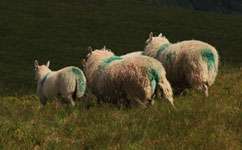Tailored solutions best for costly sheep infection

You might not have heard of sheep scab. It's not a human health risk and there's no co-ordinated treatment programme. But it's unpleasant and potentially fatal to sheep, and it costs UK farmers around £8 million a year.
Now scientists have worked out how farmers can slow the spread of the disease. Simply knowing whether to treat all your sheep regularly, or on a case-by-case basis, could reduce the number of treatments required and help avoid devastating outbreaks.
Since deregulation in 1992 there's been an increase in the number of outbreaks in the UK from less than 100 per year to an estimated 7000 by 2003. But while some farms suffer repeated outbreaks, others never or rarely do, and with uncertainty about the risks, some farmers choose to take a chance rather than fork out for preventative treatment.
Scientists from the University of Bristol have identified some clear risk factors for the transmission of sheep scab. Their work suggests that coordinated solutions tailored separately for upland and lowland farms could offer a cost-effective way of dealing with the disease.
Otherwise known as psoroptic mange, sheep scab is transmitted by mites that can live for up to 16 days anywhere an infected sheep has been, like fences, pens or lorries. And there's often a long delay between infection and visible signs appearing, so it's a difficult disease to contain.
"It's an overlooked disease," says Dr. Hannah Rose, lead author of the study which is published in the Journal of Preventive Veterinary Medicine.
"If left untreated sheep scab can be fatal," explains Rose. 'Treatment can be costly but we don't know the full effects of the disease on the animals so can't accurately estimate the cost of outbreaks.''
"Another problem is that some of the treatments for scab are the same as those used to treat certain worm infections, and overuse may contribute to the development of drug resistant worms. Better control of this disease is essential," explains Rose.
So treatment is important on welfare and economic grounds, but farmers need to understand what aspects of their husbandry put them most at risk, so they can focus their efforts on effective control.
"Some farmers are treating their flocks for scab regularly, but they have no hope of controlling the disease if their neighbors aren't doing the same thing. Farmers are already aware that common grazing and contact with neighbours' sheep can increase the risk of disease in their flocks. But if we can provide information to help farmers understand and assess the risks then they may be better able to control the disease, reducing the costs associated with repeated outbreaks and treatments," says Rose.
To find out what could be behind the patterns of infection, the researchers visited 16 randomly selected farms which had had repeated outbreaks of sheep scab over the last ten years. They also visited 16 farms with little or no history of scab, which matched the others as closely as possible in terms of geographical location and flock size.
They discussed every aspect of sheep husbandry with each farmer, including use of common grazing, 'away grazing' on other farms during winter, frequency of contact with neighbours' sheep, quarantine practices for bought-in animals, and scab treatment regimes.
They also surveyed flocks of Welsh Mountain and Brecknock Mountain ewes and lambs from three farms, on a common grazing area in the Brecon Beacons National Park in Wales, to see how much the separate flocks mixed.
When the researchers compared scab outbreaks with the different husbandry practices they found that common grazing, having neighbors with scab, and contact with neighbors' sheep, increased the risk of repeated scab outbreaks by up to 10 times.
They also saw a difference between upland farms, which use common grazing and are at high risk of repeated outbreaks, and lowland farms which have a lower risk of outbreaks as they are more likely to keep their sheep on their own land and have better access to secure quarantine areas for new sheep.
Until now no one has quantified these risks and the differences the researchers have identified mean that upland and lowland farmers could do well to take quite different approaches to treating scab.
Lowland farmers could be reactive, treating outbreaks as they arise which would avoid overuse of expensive drugs. Upland and hill farms, on the other hand, which have a higher risk of repeated outbreaks, could adopt a coordinated and systematic treatment regime with an emphasis on prevention rather than cure.
Local cooperation in extensive husbandry systems has, in the past, proved successful in eradicating sheep scab from areas of common grazing, as the Cheviot Sheep Scab Group and Dartmoor Commoner's Council have demonstrated.
This story is republished courtesy of Planet Earth online, a free, companion website to the award-winning magazine Planet Earth published and funded by the Natural Environment Research Council (NERC).
More information: Hannah Rose & Richard Wall. Endemic sheep scab: risk factors and the behaviour or upland sheep flocks. Preventive Veterinary Medicine (2011), doi: 10.1016/j.prevetmed.2011.10.010
Provided by PlanetEarth Online













